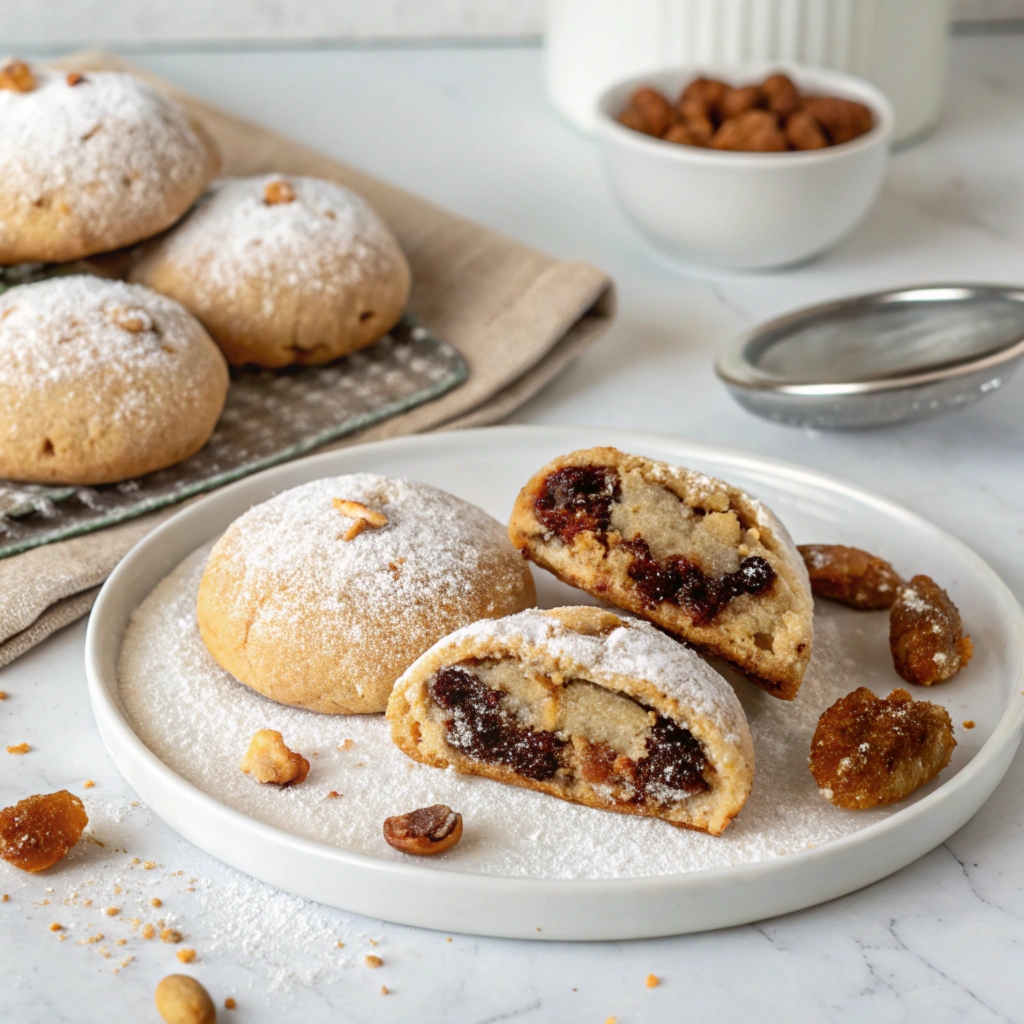Origins and Cultural Significance of Cuccidati
Cuccidati, also known as Sicilian fig cookies, hold a special place in Italian culinary tradition, particularly during the holiday season. Discovering a traditional cuccidati recipe can help you recreate these tender, fruit-filled pastries, which are believed to have originated in Sicily, reflecting the island’s rich cultural history influenced by Arab and Mediterranean cuisines. The inclusion of figs, a fruit historically abundant in Sicily, symbolizes prosperity and fertility. Cuccidati cookies are often a staple on festive tables, celebrated for their intricate flavors and decorative appearance, often adorned with colorful sprinkles or icing. These cookies represent a labor of love, uniting families in the baking process and serving as a nostalgic reminder of heritage and togetherness.
Ingredients Needed for Cuccidati recipe
Creating Cuccidati requires two primary components: the sweet dough and the fig filling. Below is a breakdown of what you’ll need:
Fig Filling Ingredients
- 1 cup dried figs, coarsely chopped
- 1 cup golden raisins
- 1/3 cup chopped walnuts or almonds (optional)
- 1/4 cup orange juice
- 1/2 teaspoon ground cinnamon
- 1/4 teaspoon ground cloves
- 1/2 teaspoon grated orange zest
- 1/4 cup granulated sugar
Sweet Dough Ingredients
- 2 1/2 cups all-purpose flour
- 1/2 cup granulated sugar
- 1/2 teaspoon kosher salt
- 1 teaspoon baking powder
- 1/2 cup cold, cubed unsalted butter
- 2 large eggs
- 2 teaspoons vanilla extract
- 1 tablespoon fresh orange juice
Step-by-Step Instructions
Follow these detailed steps to create authentic Cuccidati that will impress family and friends alike.

Preparing the Fig Filling
- Soak the Dried Fruits: Place the chopped figs and golden raisins in a bowl with orange juice. Let them soak for about 20 minutes to soften.
- Combine Ingredients: In a food processor, blend the soaked fruits, walnuts (if using), cinnamon, cloves, orange zest, and granulated sugar until a sticky paste forms. Adjust the consistency by adding a bit of warm water if needed.
- Chill the Mixture: Transfer the fig filling to an airtight container and refrigerate for at least an hour or until ready to use. This step allows the flavors to meld.
Making the Sweet Dough
- Mix Dry Ingredients: In a medium bowl, whisk together the all-purpose flour, sugar, kosher salt, and baking powder.
- Incorporate Butter: Add cold, cubed butter to the dry ingredients. Using a pastry cutter or your fingers, work the butter into the mixture until it resembles coarse crumbs.
- Form the Dough: In a separate bowl, whisk the eggs, vanilla extract, and orange juice. Pour this into the dry mixture and stir until a rough dough forms.
- Chill: Shape the dough into a ball, wrap it in plastic wrap, and refrigerate for at least 30 minutes. This step ensures the dough remains firm and easy to work with.
Assembling the Cuccidati
- Roll the Dough: On a floured work surface, roll out the chilled dough into a rectangle approximately 1/8-inch thick.
- Shape the Filling: Take small portions of the fig filling and roll them into log shapes about 1 inch wide.
- Encase the Filling: Cut the dough into strips wide enough to enclose the filling. Place a filling log onto each strip, fold the dough over, and seal the edges by pressing gently.
- Slice and Shape: Cut the filled dough into 1- to 2-inch pieces and arrange them on parchment-lined baking sheets.
Baking the Cuccidati
- Preheat the Oven: Set your oven to 375°F (190°C).
- Bake: Place the baking sheets on a rack in the middle of the oven and bake for 15-18 minutes, or until the cookies turn golden brown.
- Cool: Transfer the baked cookies to a wire rack to cool completely before decorating.
Tips for Achieving the Perfect Texture and Flavor
- Use Cold Butter: This helps achieve a tender, buttery dough that is easy to work with.
- Flavor Enhancements: Add lemon zest or a splash of almond extract to the dough for additional complexity and depth of flavor.
- Avoid Overfilling: Too much filling can cause the dough to tear or the cookies to lose shape during baking. Aim for a balanced ratio of dough to filling.
- Chill Between Steps: Keeping both the dough and filling cool ensures clean assembly and prevents stickiness. If the dough becomes too soft, return it to the refrigerator before proceeding.
- Bake Evenly: Use rimmed baking sheets lined with parchment paper to prevent sticking and to promote even browning. Rotating the baking sheets halfway through the bake time can also help.
Variations of Cuccidati
Chocolate-Covered Cuccidati
For a rich and indulgent twist, dip baked Cuccidati in melted dark chocolate. Use good-quality 70% dark chocolate bars for the best results. Let the chocolate coating set on a parchment-lined baking sheet before serving. You can also drizzle white chocolate over the dark chocolate coating for a decorative effect.
Nut-Free Cuccidati
To make nut-free Cuccidati, simply omit the nuts from the fig filling. Consider adding extra dried fruits, such as golden raisins or chopped dates, to maintain a satisfying texture and flavor.
Decorating Cuccidati with Icing
Decorating these cookies adds a festive touch. Mix powdered sugar with a few drops of warm water, fresh lemon juice, and vanilla extract to create a glossy icing. Divide the icing into portions and tint with food coloring if desired. Use a pastry brush or piping bag to decorate, and immediately sprinkle nonpareil or colorful sprinkles on top. Allow the icing to set completely before storing or serving.
How to Store Cuccidati
- Room Temperature: Store in an airtight container lined with paper towels to absorb excess moisture and keep the cookies fresh for up to a week. Layer cookies with parchment paper to prevent sticking.
- Refrigeration: If you live in a warm climate, refrigerate the cookies in a tightly sealed container to extend their shelf life.
- Freezing: Place the cookies in a freezer-safe container with parchment paper between layers. Freeze for up to three months. Thaw at room temperature before serving.
- Reheating: For a freshly baked taste, warm the cookies in a preheated oven at 300°F for a few minutes after thawing.
Other Traditional Italian Cookies to Try
Biscotti
Biscotti are twice-baked cookies known for their crunchy texture and versatility. Flavored with almonds, anise, or chocolate, these cookies pair wonderfully with a cup of coffee or dessert wine. Try dipping them in melted chocolate for an extra indulgent treat.
Pizzelles
Pizzelles are thin, waffle-like cookies made using a special pizzelle iron. Traditionally flavored with anise or vanilla, they are crispy and light, making them a perfect addition to holiday dessert spreads. Dust them with powdered sugar for a festive presentation.
Amaretti
Amaretti cookies are soft and chewy almond cookies with a delicate, nutty flavor. Made from almond flour or ground almonds, these cookies often feature a dusting of powdered sugar. They are a delightful accompaniment to espresso or as part of a dessert platter.
Cuccidati, with their sweet fig filling and tender pastry dough, are a beloved part of Italian culinary tradition. Whether you enjoy them during the holidays or year-round, these cookies are sure to delight with their rich flavors and cultural significance. Try this recipe, and explore other Italian cookies to expand your baking repertoire!
For more recipes and inspiration, check out our sourdough bagel recipe or explore creative cottage cheese recipes on Recipes Focus!


2 thoughts on “Traditional Cuccidati: A Step-by-Step Recipe for the Perfect Italian Fig Cookie”